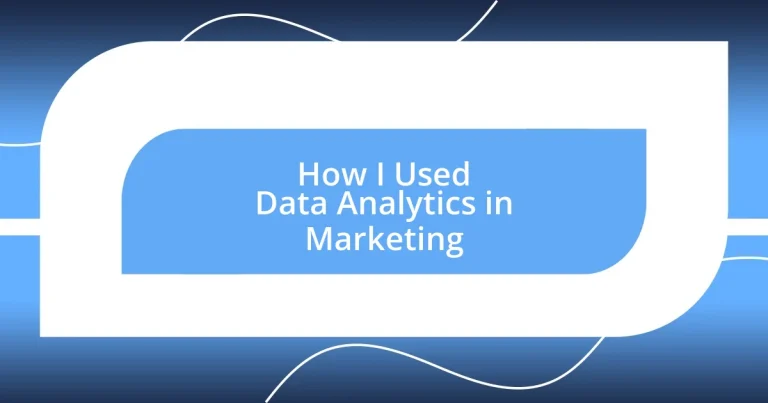Key takeaways:
- Data analytics transforms marketing by revealing customer insights, allowing for tailored strategies that enhance engagement and conversions.
- Identifying key performance indicators (KPIs) such as conversion rate and customer acquisition cost is essential for evaluating the effectiveness of marketing efforts.
- Collecting and organizing data efficiently, including utilizing CRM systems and segmenting by demographics, leads to improved campaign targeting and overall success.

Understanding Data Analytics in Marketing
Data analytics in marketing is like holding a magnifying glass over your audience’s behavior. I remember conducting my first campaign and feeling overwhelmed by the sheer volume of data. It struck me how much I could learn from customer interactions—who was clicking, who was buying, and what content sparked their interest. Isn’t it fascinating how numbers can reveal so much about people?
Understanding data analytics means diving deep into the stories behind the stats. I once analyzed the results of an email campaign, and it felt like piecing together a puzzle. The click-through rates indicated a clear preference for certain topics, which inspired me to tailor future content. Have you ever noticed how a small tweak can lead to significant shifts in engagement?
At its core, data analytics empowers marketers to make informed decisions. I recall a moment when I adjusted a social media strategy based on demographic insights. The result? A noticeable increase in engagement and conversions! Isn’t it rewarding to witness the impact of data-driven choices? This journey has shown me that marketing isn’t just about promotion; it’s about understanding and connecting with real people.

Identifying Key Performance Indicators
Identifying key performance indicators (KPIs) is a crucial step in leveraging data analytics for effective marketing. I distinctly remember the excitement of choosing the right KPIs during one of my campaigns; it was like selecting guides on a journey. I realized that these indicators had to resonate with my goals and provide clarity on how well I was engaging my audience.
Here are some essential KPIs that I found invaluable:
- Conversion Rate: Measuring the percentage of visitors who complete a desired action can show how effective your content is.
- Customer Acquisition Cost: Understanding the cost associated with acquiring a new customer helps me evaluate the efficiency of my marketing strategies.
- Retention Rate: Keeping existing customers is as critical as gaining new ones, and this metric helps in assessing loyalty.
- Click-Through Rate: I always consider this metric, as it captures the initial interest level of my audience in a campaign.
- Return on Investment (ROI): Analyzing the revenue gained in comparison to the amount spent on marketing efforts gives a clear picture of profitability.
Each KPI tells a story of its own, and harnessing this data has transformed my approach to marketing, allowing me to fine-tune strategies and ultimately connect better with my audience. It’s almost like building a unique fingerprint of my marketing effectiveness!

Collecting and Organizing Data Efficiently
Collecting data efficiently is the foundation of any successful data-driven marketing strategy. I remember the first time I used customer surveys to gather insights. It was eye-opening! I realized that crafting questions carefully made all the difference. By focusing on open-ended queries, I could extract deeper insights than from simple yes/no options. This experience taught me to always think about how I can formulate questions to maximize the value of the data I collect.
Once I had my data, organization became crucial. I began using spreadsheet software to categorize and analyze my findings. I’d group data by demographics, purchase behavior, and feedback themes. This structure allowed me to visualize trends easily. Have you ever noticed how a clear layout can make complex data much more manageable? Often, it’s the simplicity that reveals vital patterns. My personal preference is to leverage color coding and filters, making the data not just informative, but visually engaging.
Another valuable lesson I’ve learned is the importance of a centralized database. Early on, I juggled multiple platforms, and it often led to confusion and redundancy. Transitioning to a Customer Relationship Management (CRM) system streamlined my data collection and nurturing processes. I felt a sense of relief seeing everything in one place. This efficiency not only saved me time but also allowed me to focus more on strategic analysis rather than getting bogged down by data chaos.
| Data Collection Method | Advantages |
|---|---|
| Surveys | Gain detailed feedback and customer insights. |
| Spreadsheets | Organized data visualization for analysis. |
| CRM Systems | Centralized data management reduces confusion. |

Analyzing Consumer Behavior Trends
Understanding consumer behavior trends is like tuning into a well-played symphony. I recall a campaign where I utilized social media analytics to identify trending topics. It felt invigorating to see how real-time data revealed the emotions and interests driving my audience. Diving into those analytics allowed me to pivot my messaging in a way that resonated deeply, almost like having a direct line to their thoughts.
Another noteworthy experience was when I applied heat maps to a landing page to visualize where users clicked most often. The vivid imagery of consumer interaction struck me! It was like peering into the minds of visitors. This analysis guided me to enhance user experience by placing key content spots in those high-click areas. Have you ever been surprised by what people ignore versus what captures their attention?
Moreover, segmenting these insights by demographics transformed my approach to targeting. I realized an ad campaign aimed at millennials felt entirely different when the data showed that my audience was predominantly Gen Z. It was a lightbulb moment! I took a step back, re-evaluated my strategy, and tailored my approach accordingly. Just as I cherish the joy of a perfectly aligned puzzle piece, seeing the right data insights come together to shape my marketing strategy felt equally rewarding.

Using Insights for Targeted Campaigns
Using insights from my data collection has been pivotal for crafting targeted campaigns. I remember the transformation I experienced after segmenting my email lists based on purchasing behavior. Suddenly, I was no longer sending generic blasts; instead, I could tailor my content to specific interests, leading to a remarkable increase in engagement. Doesn’t it feel more rewarding to connect with customers when the message truly resonates? I found that personalizing my approach not only elevated conversion rates but also built lasting relationships with my audience.
In another instance, I leveraged insights from customer feedback to develop a campaign that highlighted product features most praised by users. The joy of crafting a message that reflected our customers’ voices was incredibly fulfilling! I recall the rush I felt as I saw higher click-through rates, knowing that I had tapped into the desires of my audience. It’s fascinating how aligning your message with what your customers value can create a sense of community, don’t you think?
I’ve also experimented with geographic data to localize my campaigns. I vividly remember the reaction to a targeted promotion centered around an upcoming local event, which I discovered through analytics. By showcasing how our products fit into the lifestyle of the event-goers, we drove foot traffic in ways I hadn’t anticipated. It was exhilarating to watch the numbers climb as our strategies aligned with real-world events, reinforcing the necessity of being in tune with both data and context.

Measuring Success and ROI
When it comes to measuring success and ROI in marketing, I’ve learned that numbers can tell a compelling story. I remember one campaign where I monitored our customer acquisition cost (CAC) closely. Watching that number gradually decrease as we refined our targeting strategies felt like watching a garden bloom—no longer choked by weeds of inefficiency. Have you ever experienced that moment when the data just clicks? It’s like a wave of relief, knowing your marketing dollars are working harder for you.
Another aspect I focus on is the lifetime value of a customer (LTV). I once delved into the relationship between our marketing efforts and customer loyalty. Analyzing this metric was captivating; it provided insights into how long a customer typically stayed engaged with our brand before churning. I distinctly remember feeling a rush of excitement when I realized that a small percentage of our customers were generating a disproportionate share of revenue. It highlighted the importance of nurturing those relationships, rather than just focusing on immediate sales.
Lastly, I’ve found that setting clear benchmarks is critical to understanding our performance. I started using data dashboards that displayed key performance indicators (KPIs) front and center. I vividly recall my first quarterly review, where I could transparently showcase growth against those targets. That visual representation of success—and areas for improvement—was like a breath of fresh air. Isn’t it empowering to have a snapshot of your efforts? It spurred me on to constantly refine my approach and keep moving forward.














